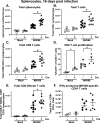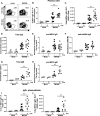T Cell-Specific STAT1 Expression Promotes Lytic Replication and Supports the Establishment of Gammaherpesvirus Latent Reservoir in Splenic B Cells
- PMID: 35968944
- PMCID: PMC9430880
- DOI: 10.1128/mbio.02107-22
T Cell-Specific STAT1 Expression Promotes Lytic Replication and Supports the Establishment of Gammaherpesvirus Latent Reservoir in Splenic B Cells
Abstract
Gammaherpesviruses establish lifelong infections in most vertebrate species, including humans and rodents, and are associated with cancers, including B cell lymphomas. While type I and II interferon (IFN) systems of the host are critical for the control of acute and chronic gammaherpesvirus infection, the cell type-specific role(s) of IFN signaling during infection is poorly understood and is often masked by the profoundly altered viral pathogenesis in the hosts with global IFN deficiencies. STAT1 is a critical effector of all classical IFN responses along with its involvement in other cytokine signaling pathways. In this study, we defined the effect of T cell-specific STAT1 deficiency on the viral and host parameters of infection with murine gammaherpesvirus 68 (MHV68). MHV68 is a natural rodent pathogen that, similar to human gammaherpesviruses, manipulates and usurps B cell differentiation to establish a lifelong latent reservoir in B cells. Specifically, germinal center B cells host the majority of latent MHV68 reservoir in the lymphoid organs, particularly at the peak of viral latency. Unexpectedly, T cell-specific STAT1 expression, while limiting the overall expansion of the germinal center B cell population during chronic infection, rendered these B cells more effective at hosting the latent virus reservoir. Further, T cell-specific STAT1 expression in a wild type host limited circulating levels of IFNγ, with corresponding increases in lytic MHV68 replication and viral reactivation. Thus, our study unveils an unexpected proviral role of T cell-specific STAT1 expression during gammaherpesvirus infection of a natural intact host. IMPORTANCE Interferons (IFNs) represent a major antiviral host network vital to the control of multiple infections, including acute and chronic gammaherpesvirus infections. Ubiquitously expressed STAT1 plays a critical effector role in all classical IFN responses. This study utilized a mouse model of T cell-specific STAT1 deficiency to define cell type-intrinsic role of STAT1 during natural gammaherpesvirus infection. Unexpectedly, T cell-specific loss of STAT1 led to better control of acute and persistent gammaherpesvirus replication and decreased establishment of latent viral reservoir in B cells, revealing a surprisingly diverse proviral role of T cell-intrinsic STAT1.
Keywords: STAT1; T cell; acute infection; chronic infection; gammaherpesvirus; germinal center B cell.
Conflict of interest statement
The authors declare no conflict of interest.
Figures








Similar articles
-
Combination of proviral and antiviral roles of B cell-intrinsic STAT1 expression defines parameters of chronic gammaherpesvirus infection.mBio. 2024 Nov 13;15(11):e0159824. doi: 10.1128/mbio.01598-24. Epub 2024 Oct 23. mBio. 2024. PMID: 39440973 Free PMC article.
-
Conserved Gammaherpesvirus Protein Kinase Counters the Antiviral Effects of Myeloid Cell-Specific STAT1 Expression To Promote the Establishment of Splenic B Cell Latency.J Virol. 2021 Aug 10;95(17):e0085921. doi: 10.1128/JVI.00859-21. Epub 2021 Aug 10. J Virol. 2021. PMID: 34132573 Free PMC article.
-
T Cell-Intrinsic Interleukin 17 Receptor A Signaling Supports the Establishment of Chronic Murine Gammaherpesvirus 68 Infection.J Virol. 2022 Jul 27;96(14):e0063922. doi: 10.1128/jvi.00639-22. Epub 2022 Jun 27. J Virol. 2022. PMID: 35758659 Free PMC article.
-
Gamma interferon blocks gammaherpesvirus reactivation from latency in a cell type-specific manner.J Virol. 2007 Jun;81(11):6134-40. doi: 10.1128/JVI.00108-07. Epub 2007 Mar 14. J Virol. 2007. PMID: 17360749 Free PMC article. Review.
-
Natural history of murine gamma-herpesvirus infection.Philos Trans R Soc Lond B Biol Sci. 2001 Apr 29;356(1408):569-79. doi: 10.1098/rstb.2000.0779. Philos Trans R Soc Lond B Biol Sci. 2001. PMID: 11313012 Free PMC article. Review.
Cited by
-
Combination of proviral and antiviral roles of B cell-intrinsic STAT1 expression defines parameters of chronic gammaherpesvirus infection.mBio. 2024 Nov 13;15(11):e0159824. doi: 10.1128/mbio.01598-24. Epub 2024 Oct 23. mBio. 2024. PMID: 39440973 Free PMC article.
-
STAT1 and herpesviruses: Making lemonade from lemons.Virology. 2025 Feb;603:110364. doi: 10.1016/j.virol.2024.110364. Epub 2024 Dec 17. Virology. 2025. PMID: 39894604 Review.
References
Publication types
MeSH terms
Substances
Grants and funding
LinkOut - more resources
Full Text Sources
Molecular Biology Databases
Research Materials
Miscellaneous

